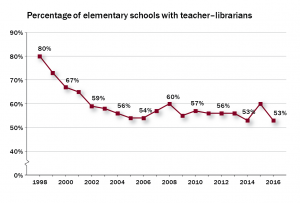School libraries
School libraries play an essential role in ensuring that Ontario’s students are prepared for today’s information- and knowledge-based society.
School library programs provide opportunities for students to develop a love of reading, an understanding of diverse texts, problem-solving skills, digital literacy, and citizenship skills. Teacher–librarians can help to foster those important skills for student success. However, there has been a decline in the number of teacher librarians over the last 15 years.
Data from People for Education’s annual report on schools show that in 2016: 
- In elementary schools, only 54% of schools have teacher-librarians, a decline from 60% last year and 80% in 1998.
- Only 10% of elementary schools report having a full-time teacher–librarian.
- The percentage of secondary schools with a teacher-librarian has increased marginally – from 72% last year to 74%. However, there has been a slight decline in secondary schools reporting full-time teacher–librarians.
While library technicians play an important supportive role in school libraries, it differs from that of teacher–librarians, who are Ontario certified teachers with specialist qualifications in librarianship. This year’s report shows that library technicians, who are paid at a lower pay scale, may be replacing teacher-librarians:
- 49% of elementary schools have a library technician, compared to 43% last year.
- 49% of secondary schools have a library technician, compared to 44% last year.
Access to a teacher-librarian may also depend on where a school is located. In 2016:
- 44% of elementary schools in small town/rural areas report having a teacher–librarian, compared to 60% of urban/suburban schools.
- 53% of elementary schools in small town/rural areas report having a library technician, compared to 46% of urban/suburban schools.
Read the School Libraries chapter from the 2016 annual report on schools.
